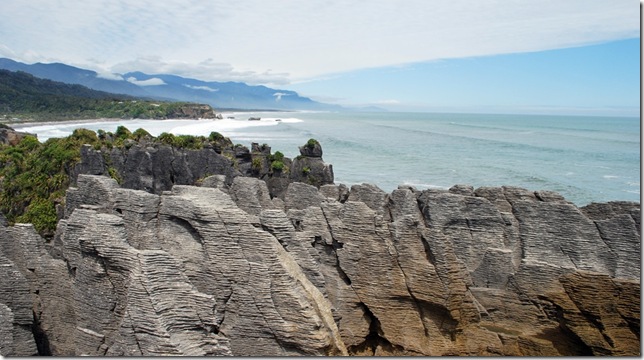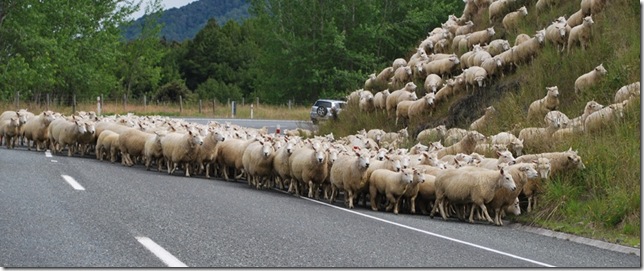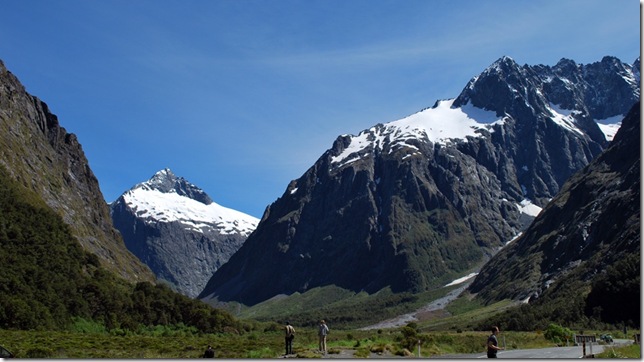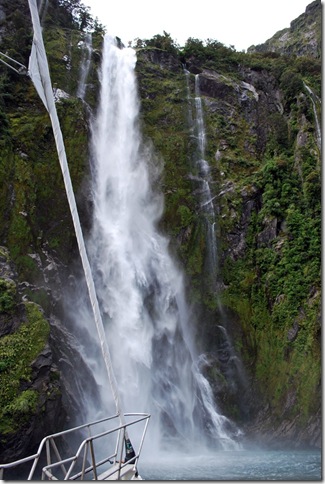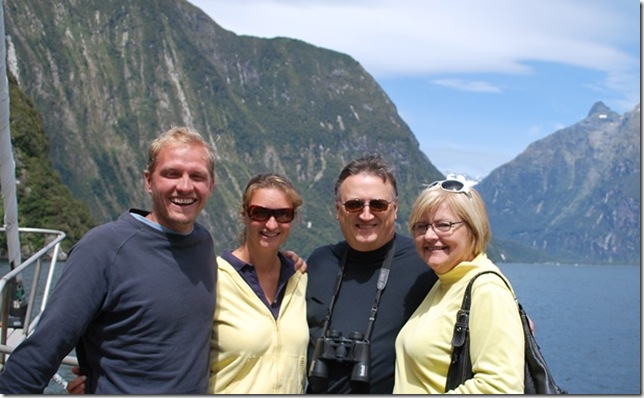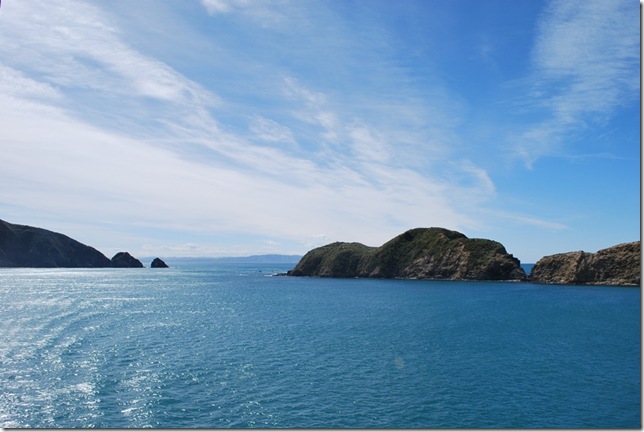Yesterday we finally left the boatyard with the bow repairs nearly complete. The good news is that we’ll be all done with a major structural repair after we apply a couple coats of epoxy paint in the anchor locker and tie the trampolines back on. The bad news is that hiring a professional boat builder to do a 3-week repair job isn’t cheap; luckily the lady from the office had me sit down when she called with the final invoice amount. Since they don’t take credit cards (direct account transfers seem to be the way most large transactions are handled here), tomorrow we start the process of trying to make an international wire transfer from overseas. To be fair, the labor rates are less here than in the states, the work was done well, and it was really nice to have a boat builder doing such an important project instead of just a run-of-the-mill boatyard. I spent the last few days working with one of the guys to finish things up, and it really is a lot of slow-going work, especially in the afternoon, when the Kiwi summer sun is out in full force.
For anyone interested in the repair details, our original problem was hull-deck separation on the starboard side of our center “bow” as well as a cracked weld on the fitting that the headstay is anchored to. When the hull and deck separated, the 6 mm through-bolts that held the inboard edge of the starboard tramp either sheared off or pulled through. Even though the boat in general is built like a tank, this particular area wasn’t built as heavily and it’s subject to a lot of stress from pounding into the waves as well as the effects of being doused in salt water frequently. Those three things as well as the age of the boat are probably what contributed to the hull-deck adhesive and two thin layers of glass inside the anchor locker finally giving way. There were a number of steps to the repair, but now we have fresh epoxy with filler in the hull-deck joint gap and six layers of glass on either side of the area that broke loose. Just to be safe, we also added six layers of glass on the inside of the opposite side. All of the eye-bolts that hold the tramps in place were replaced and enlarged as well since they’re bolted through the hull-deck joint. The bow “nose cone”/anchor roller/headstay fitting was removed, re-welded, and beefed up before being carefully replaced by first using release wax on the underside to form an epoxy “male” mated area on the bow to ensure there were no voids to collect moisture. We also took the opportunity to have the rigger replace the bearings in the roller furling as well. They had become so rusted that I had to go out to the roller furling every few days and turn it to break the rust in the bearings loose. If I’d left it more than a week or two, I’m not sure I could have broken them free by hand. It’s been an expensive but productive month so far, and we only have a couple more significant repairs to complete before the repair list is down to a bunch of small stuff.
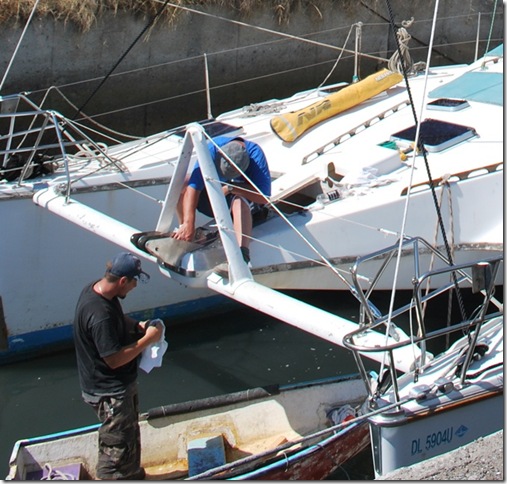 Starting to put things back together
Starting to put things back together
We’ve had a couple people ask us about (non-boat) work. We’re both just slightly too old for the easily acquired unrestricted NZ work visas (we would need a job and a sponsor in advance to get a work visa), and my plans to telecommute from NZ ran into a couple hitches, so we’re currently considering a trip back to the states to add to the kitty, but nothing has been finalized yet.
On a somewhat related note, we’ve also been spending a lot of time contemplating our route back to the US. We budgeted time and money for a 2-year trip via the Suez and Panama Canals, but our later than expected shove-off date led us to alter our plans and spend a season in New Zealand so that we could spend more time in the Pacific Islands. Now we’re left with a couple of options. One option is to take the Suez Canal route as we’d originally planned. The upside to the Suez Canal route is that there’s really a lot to see in terms of different cultures – Thailand, Sri Lanka, the Middle East, Egypt, Turkey, southern Europe, and Morocco. The downsides are the Somali pirates, rough upwind sailing in the Red Sea, poor sailing conditions across the Med, and expensive marinas with few anchorages in southern Europe. The Suez route would also add 8-12 months to our trip due to the need to schedule the trip according to the appropriate seasons. The other option is to cross the southern Indian Ocean and return via South Africa and the Cape of Good Hope. The South Africa route includes several long offshore passages, but goes much quicker due to the way the seasonal timing works out. Aside from visiting fewer countries, the traditional downside to the South Africa route is the area of frequently rough seas south of Madagascar, where numerous circumnavigators have gotten into trouble among the large, confused waves. The potentially rough seas south of Madagascar have us looking at another option as well that would take us north of Madagascar and allow us to see Chagos, Madagascar, and Mozambique while avoiding the southern tip of Madagascar and crossing the Mozambique channel in a fairly short time with a good weather window. I’ve updated the Route page to show the different options so you can get an idea of what the timing and routes would look like. Lauren also uploaded several new albums of NZ pics, so the Photos link has something new to see for the first time in a while.
 Three routes across the Indian Ocean
Three routes across the Indian Ocean
After leaving the boat builder’s slipway at high tide and making the trip back across the river to the marina, we noticed a familiar stern right across from us. The boat Kattywompus, with Brad and Linda from Seattle, had found their way to Tauranga. We’d met them briefly in Ua Pou and enjoyed visiting with them there, and it was nice to see them again several thousand miles and six months later. It turns out they were coming into Opua just as we were leaving and are now on their way to the South Island on their boat. Talking to them reminded us how much we enjoy being on the move, seeing new places, and meeting new people. There’s an old sailing saying that goes “ships and crew rot in port.” So far we’ve managed to avoid both.
We spent the rest of our South Island tour heading up the West Coast and back to where we started in the Marlborough region. Our first stop along the way was the Fox Glacier. This huge mass of ice is about 8 miles long, and this is how far the ice travels over a period of many years from its highest point in the Southern Alps to its terminal face near the coast, where the old ice begins to melt. As we were walking toward the terminal face, we were stopped by a member of the NZ Department of Conservation who told us that large boulder had recently fallen from the mountain into the foot path. She instructed us to be alert, and if we saw one coming, to run as fast as we could! The risk obviously was not so severe as to require them to shut down the area to tourists, but nevertheless, the warning produced some understandably disconcerted expressions on the faces of those for whom running involves considerable effort! We did not in fact see any falling boulders on the way to or from the glacier, but we did have to traverse two creeks that had descended from waterfalls of melting ice. The streams’ paths changed so frequently that the stepping stones that we used on the way to the glacier were covered in water on the way back. The glacier itself has changed quite dramatically as well, though it hasn’t receded as much as most around the world because it faces the strong westerly winds from the Tasman Sea. We were able to get pretty close to the terminal face and were impressed by the visible layers of compressed ice. Apparently the terminal face is comprised of pure hydrogen (the oxygen has been squeezed out). My understanding is that this is why it has a light blue tint to it, whereas the water streaming from it is gray.
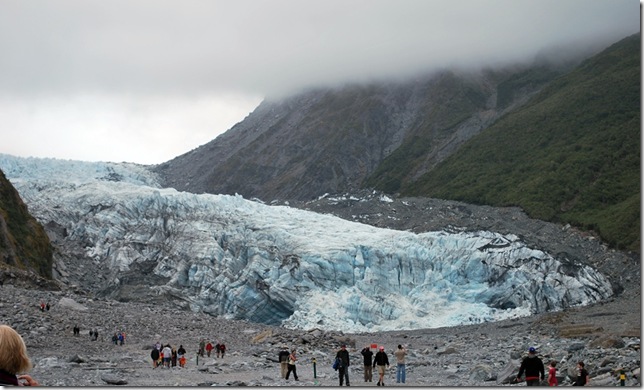 Look at the people on the far left to get a sense of the glacier’s size
Look at the people on the far left to get a sense of the glacier’s size
We continued up through dense rainforest to Greymouth. This quaint town was another former hub for gold mining, and interested tourists can pan for gold at Shantytown, one of the local attractions. We arrived at our B&B after 6:00 and were served traditional tea and biscuits by our hostess Mary, a charming English widow with a bit of a rough edge (her husband was a commercial fisherman). Her house had not been updated in many decades, and she invited us to have a seat in front of the fire into which she shoveled a load of coal. It seemed as though we were back on the vintage steamship for a moment! We went out for a nice dinner at the Speights (“the beer of the Southern man”) Ale House and returned for some TV and political discourse with Mary and her German guest, Wolf.
On our way out of town the next day, we stopped at a local jade (“pounamu” in Maori) gallery, since all four of us had taken an interest in the stone during our travels around the South. Pounamu has been an important part of the culture of Southern Maori tribes for hundreds of years, and to this day these tribes are the only ones permitted to excavate it. We found the studio/gallery of a local artisan, Garth, who was a descendant of one of the tribes and learned to identify and carve the stone from his father. His talent was obvious, as was his passion for the art, and he happily explained the process from start to finish, comparing notes with Dad (a bronze sculptor). Pounamu is a challenging medium because it is so hard—only diamond blades and diamond sand paper will do the trick! Mom and I both left with beautiful pendants, but Maori tradition calls for giving away one’s first piece, so we are just “looking after them” according to Garth.
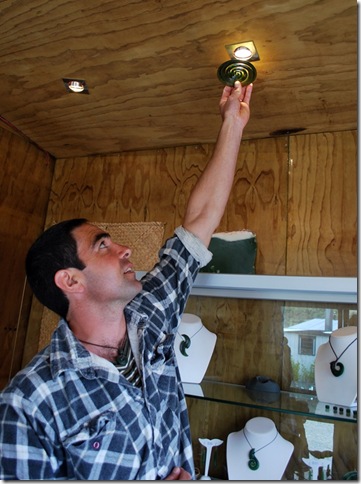 Garth showing us the various shades of green
Garth showing us the various shades of green
Our second stop, just off the motorway, was also quite memorable. The Pancake Rocks are limestone formations along the coast that really do resemble stacks of pancakes. Geologists aren’t 100% sure how they came to be but believe that between layers of limestone there used to be layers of a softer mudstone that was more vulnerable to erosion from waves (hence the gaps between pancakes). However they got there, they make for quite a vista surrounded by rainforest and the rocky coastline!
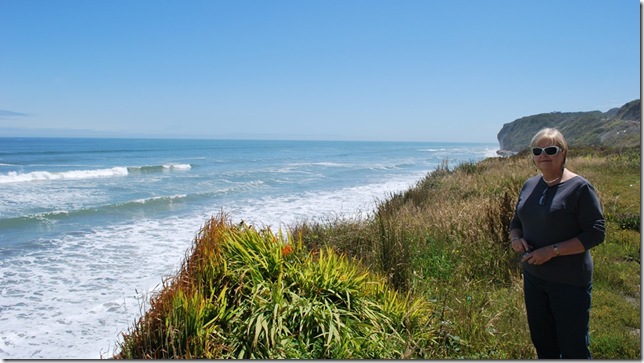 Stopping for a view of the West Coast
Stopping for a view of the West Coast
We followed this coastline on up through dense forest, over the mountain pass, and down into the lovely valleys of the Marlborough region. (Our “caaa” has been put to the test, especially with four lead-foot drivers!) We spent the next four restful nights at a very accommodating B&B in the town of Blenheim, which is making a name for itself as a result of its plentiful vineyards and world-famous Sauvignon Blanc. We set out to sample a few (more like several) over a couple of days and learned about the characteristics and processes used to create the typical white varieties. Our favorites came from the Te Whare Ra (“the house of the sun” in Maori) winery with only four employees, and we took a bottle back to the the sunny yard of the B&B to enjoy along with some goat cheese and fresh bread. What better way to finish off a whirlwind tour? We also visited the Aviation Heritage Museum, home to a bunch of replicas of World War I planes including that flown by the “Red Baron”. Finally, we spent our last day in the South Island in nearby Nelson, a slightly larger city that is known for its arts, food, and its proximity to the beaches of the Abel Tasman National Park. We got a taste of all of this, from the very impressive collections from local and national artists at the public art gallery, to the creative and inexpensive dishes served at the cafe, to the fine white sand of the local beach.
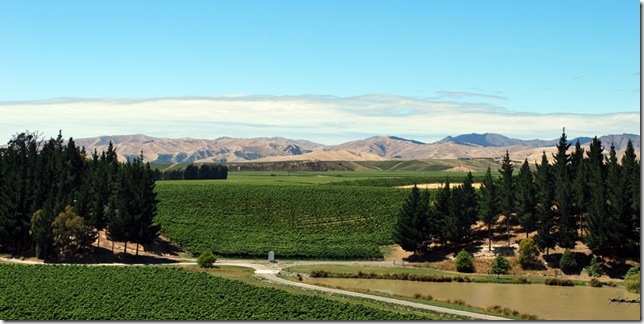 Spectacular view from the tower at the Highland Winery
Spectacular view from the tower at the Highland Winery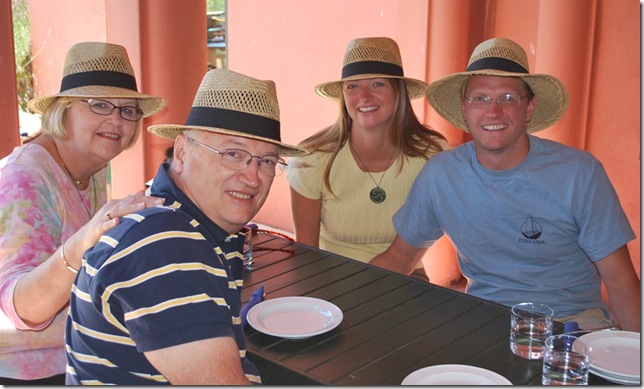 Our sun hats didn’t protect us from the farmer-tan!
Our sun hats didn’t protect us from the farmer-tan! 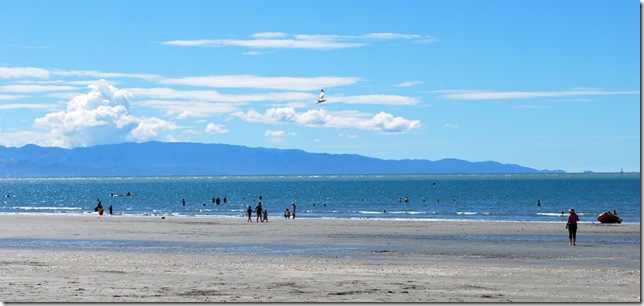 A gorgeous day at Abel Tasman National Park in Nelson
A gorgeous day at Abel Tasman National Park in Nelson
Once back in the North, we took a different route than before and were very surprised to find desert after just having driven through a forest! We were all amazed at how diverse the landscape is for such a small country and how rapidly it changes from one to the next. During the course of our trip, we saw what reminded us of Alaska, California (north and south), Colorado, New Mexico, Florida (white sand), and Hawaii, not to mention the fjordland. I think it’s safe to say that my parents were very pleased with their decision to come all this way, although the next time I see them will probably be a little closer to home!
As I am typing, we are on a ferry getting ready to “sail” (not sure why they call it that) back to the North Island. We have had a fantastic time touring the South with my parents, and I will try to catch up in the next couple of blogs.
Queenstown is a former gold mining town that now serves as one of the primary ski locales in NZ. The ski season doesn’t begin until April, but all year round the town is “buzzing”, we are told. Queenstown is touted as the adrenaline capital of NZ, featuring plenty of extreme adventure sports such as heli-biking (dropping onto the top of the mountain from a helicopter and biking down), lugeing, and skydiving. As for us, Mom had her heart set on bungee jumping, but we talked her out of it. Seriously, though, there was no shortage of activities suited to all our tastes. It was pretty cold and rainy for the first two days of our stay (very atypical for this time of year), which interfered with the view but not our good times. My parents had rented out a cozy vacation home in a nearby ski village, and we took full advantage of the fireplace, under-the-floor heating system, and dishwasher. Such luxury!
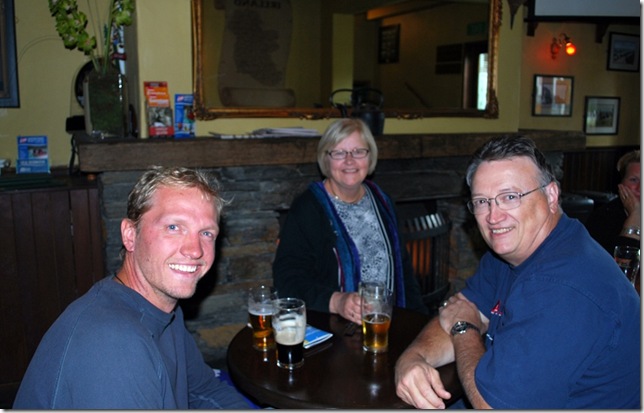 The Irish pub is always a good place to wait out the rain
The Irish pub is always a good place to wait out the rain
One of the sights in Queenstown that appealed to all of us was the Kiwi and Birdlife Park where we saw live kiwis being fed. Kiwis are flightless birds in the same family as the ostrich, They are nocturnal and somewhat rare due to predators (e.g., stoats and possums) introduced by settlers from other countries that attack the young. As a result, they are hard to get a glimpse of in the wild, but the Park had two of them on display in a room with infrared lights designed to simulate nighttime. They could be seen searching through the mulch for food using their very long beaks, at the ends of which are some of their most important assets, the nostrils. Our knowledgeable guide explained that one of the reasons that kiwis have become a national symbol is that they are such tough little guys. Once fully grown, they are highly resistant to attacks from land mammals due to their fierce kick and can survive in harsh conditions since they will eat anything. Other interesting facts include that 3-4 times per year, the adult female lays an enormous egg–the equivalent of a woman giving birth to a 37 lb newborn! After the birth, Mum goes off to mark her territory while Dad incubates the egg for 70-90 days, during which time he loses 20% of his body weight! How’s that for teamwork? We learned about some other fascinating animals’ behaviors and characteristics, but I better move on before this starts to sound like a term paper for Biology class!
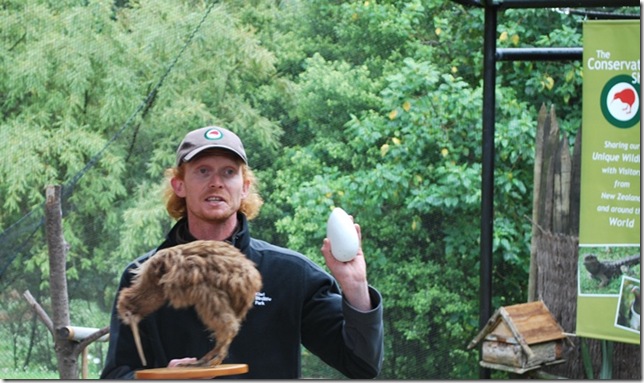 Model of a kiwi and her enormous egg
Model of a kiwi and her enormous egg
When the weather improved, we took a trip on the TSS Earnslaw, a vintage steamship originally launched in 1912 but in seemingly excellent condition today. We were able to go below and watch the stoker as he scooped coal into the fire, and we learned that, in the process of heating water to create the steam that drives three pressurized cylinders, a ton of coal is consumed in just an hour. Probably not a very “green” way to travel, but it was cool nonetheless.
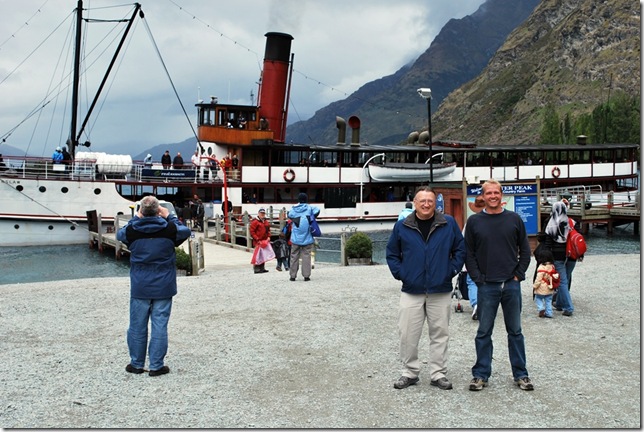 Disembarking from the TSS Earnslaw
Disembarking from the TSS Earnslaw
The Earnslaw took the four of us across the lake at the base of Queenstown’s mountains to our destination, the Walter Peak High Country Farm. Once at the Farm, we were met by our tour guide who was quite a character. He fed us one line after another while introducing us to the resident reindeer, sheep, cattle, and alpaca. We then had afternoon tea in a ranch-style homestead before heading back outside for the sheepdog demo (the border collie was unbelievably fast and efficient at mustering the sheep) and sheep-shearing. With 35 million sheep in NZ (9 per person!), wool is a very important national resource, and it was pretty impressive to see how effortlessly the shearer could maneuver and shear an initially reluctant Merino sheep.
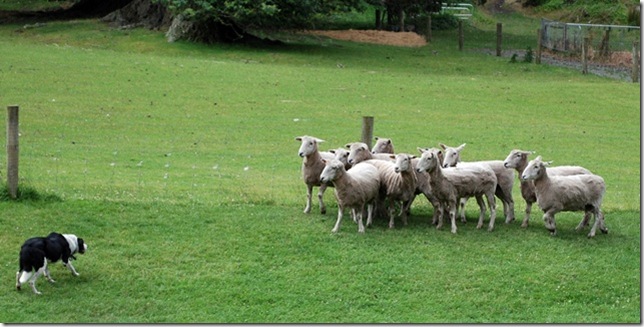 The sheep instinctively run away from the sheepdog
The sheep instinctively run away from the sheepdog
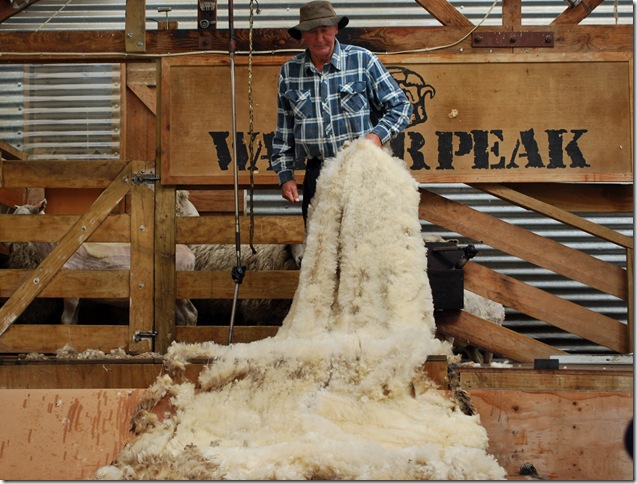 The wool from one sheep brings in about $7
The wool from one sheep brings in about $7
The following day we got up early and drove 5 hours to Milford Sound in the Fjordland National Park. As we climbed up into the mountains, there were plenty of scenic vistas, and we stopped several times for photos (and one snowball fight). Once we had to stop for a flock of sheep in the road! The shepherd could have used some more sheepdogs, as he was trying pretty unsuccessfully to corner the strays with his truck, chase them down by foot, and carry them back to the truck!
Milford’s name is a misnomer, since a “sound” is create by a flooded river, whereas Milford is a fjord—a group of steep cliffs and u-shaped valleys created by the gradual grinding down of rock by a glacier millions of years ago, the valleys of which have now been filled in by the sea. The result is spectacular and can be viewed only by sea or by air. We opted to “set sail” on a large scow. (The sails were just for show, since, in the absence of a keel, the scow would move sideways under sail alone.) The winds coming down from the cliffs are often said to blow over 100 km/hour, but the weather the best it had been in 2 weeks on the day we were there. It was a bright, sunny day as we motored around the fjords to view several waterfalls, striations in the cliffs created by the glaciers and “tree avalanches”, and fur seals lounging around on the rocks. The boat took us out into the surprisingly calm Tasman Sea before heading back into the fjords, and the view on the way back was even better.
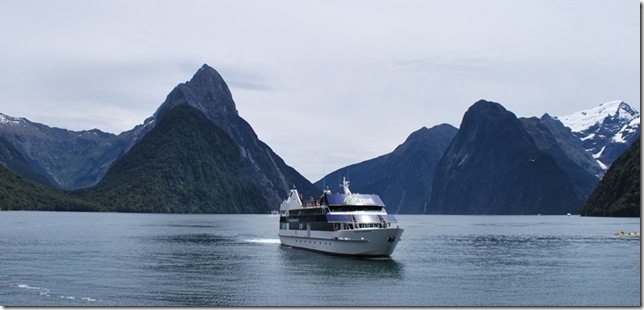 Mitre Peak is the most well known feature of Milford Sound
Mitre Peak is the most well known feature of Milford Sound
We have covered a lot of ground since our last blog, which is why we haven’t had a chance to post a new one in several days. I will try to give a brief rundown of our activities.
Before leaving Tauranga, we moved the boat to the slipway without any trouble. After seeing a couple of boats smack pilings on their way in and out of their berths as a result of intense tidal current, Dallas suggested that we move at slack tide, which seemed to have made a world of difference. We easily motored out and across the harbor where we were met by Hutchison (the boat-builder) and the riggers, who assisted Dallas in taking down the forestay. It will be so nice to have a couple of major repairs completed upon our return.
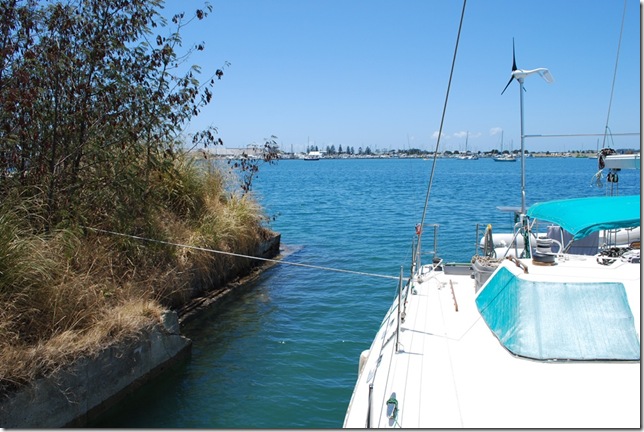 Tied up to a tree in the slipway
Tied up to a tree in the slipway
We left the boatyard at 2:00 p.m. and drove for four hours (plus a quick stop for an oil change) along the “Thermal Explorer Highway” to Napier. Along the way, we saw what looked like a nuclear stack, but it was a large geothermal power plant where the heat from seismic activity is being converted to usable energy. Napier is a colonial city on the east coast that was nearly destroyed in an earthquake in the 1930’s. It was rebuilt in the “art deco” style and is now known for this as well as its vineyards. We went out for yummy Thai food and returned to the colonial-style B&B where we were staying for a glass of locally-produced Sauvignon Blanc on the veranda before calling it a day. The next morning, our hosts fixed us a traditional English breakfast (muesli, thick sausages, baked tomato, eggs), and we were on our way. We decided it was a bit too early to be tasting wine, so we bypassed the wineries and headed on to Wellington at the southern tip of the North Island.
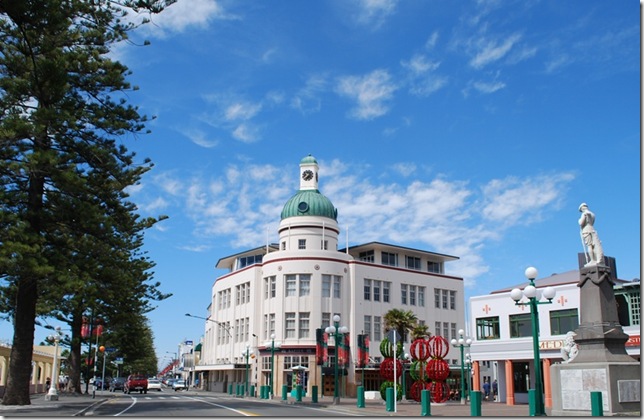 The “Art Deco” style of Napier
The “Art Deco” style of Napier
We arrived in the capital city in late afternoon and headed straight for the cable car ride. This was my suggestion, as we only had one night to spend there and wanted to get a feel for the city. As it turned out, the entire ride lasted maybe 5 minutes, so that was comical. Fortunately the last stop offered a nice view of the city, and the scenic walk back through the botanical gardens was lovely despite the chill from the winds coming down off the mountains. We had another bit of good fortune in that Te Papa, the national museum of NZ, was open late (only on Thursdays!), so we had a chance to see impressive exhibits such as the colossal squid that was accidentally caught on a hook by a fishing boat in the Southern Ocean. We also read the somewhat discrepant English and Maori versions of the Treaty of Waitangi in which the Maori chiefs granted the English the authority to rule NZ in exchange for land rights. The video demonstrations of the rituals of carving pounamu (jade) and making tapa cloth out of mulberry bark also were fascinating. It was an awesome museum and capped off another full day!
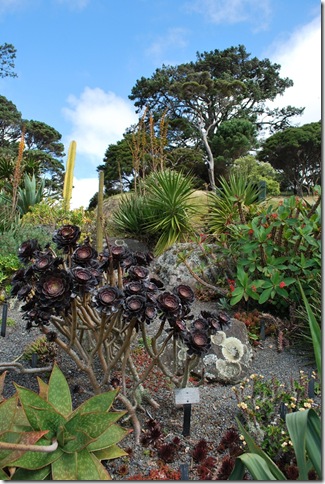 The “succulents” at the Wellington Botanic Garden
The “succulents” at the Wellington Botanic Garden
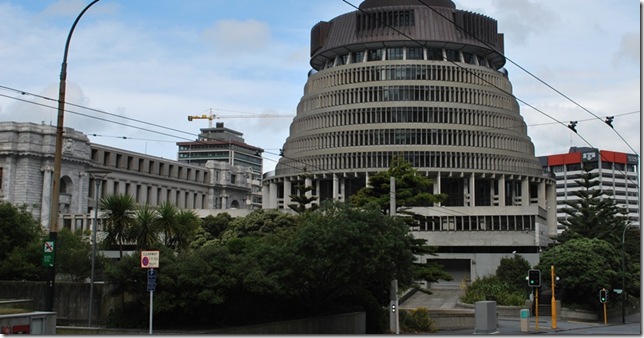 The “Beehive”, home of the NZ Parliament
The “Beehive”, home of the NZ Parliament
Our Wellington accommodations left some things to be desired (soap, for example!), but we weren’t there long, as we had to get on the ferry by 7:30 a.m. The inter-island ferry boat was massive and replete with recliners (we found these right away), two movie theaters, and a magic show for the kids (and me). The Cook Strait was about as calm as it could be, especially considering the gale warning that had been in place just 12 hours prior. My mom is very sensitive to motion but had no problems, and we all enjoyed the views from the bow as we approached Marlborough Sounds.
Once on the South Island, we drove south for 4.5 hours to Christchurch. The Marlborough region is regarded as the best in NZ in terms of its wines, so after lunch we stopped off at the Montana Winery—their wine is sold in the U.S. by a different name since the state name was expected to be a turn off to the American consumer. The four of us agreed that their whites were better than their reds. Anyway, we arrived in Christchurch, the largest city in the South, in early evening and dined at a Mexican restaurant (a Richerson favorite). The restaurant and the city center in general were quite hip, seeming to cater to the University of Canterbury crowd. The next morning we went back to the city center to check out the local markets and the local museum. Though the architecture and style of the area are clearly colonial, the local artisans seemed to peddle Maori designs such as pounamu jewelry and carved wooden masks. While walking to the museum, we heard music coming from the Arts Center and popped in to discover a group of local Maoris dressed in native garb and performing traditional songs. Dallas and I had seen a very similar performance while in the Cook Islands but were really pleased that my parents were able to see it for themselves. And we were really impressed by yet another museum. The highlight for me was the excellent photography exhibit, while Dallas was naturally drawn to the stories of the original Antarctic explorers (e.g., Shackleton).
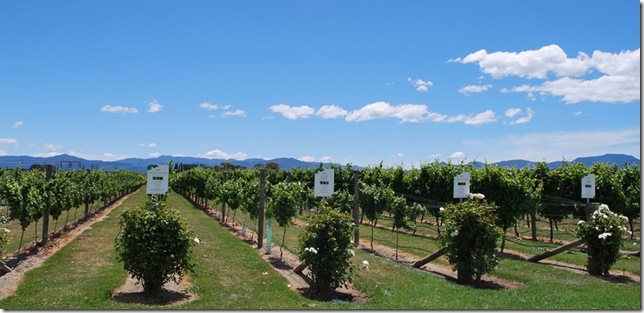 The orchards of Montana Vineyard
The orchards of Montana Vineyard
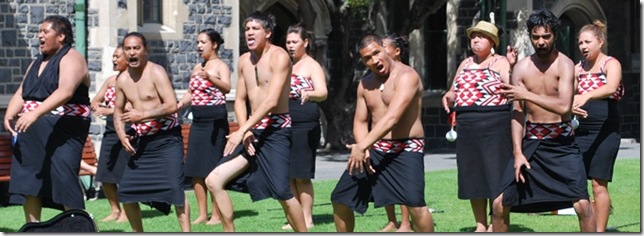 Performing the traditional “Haka” (warrior chant)
Performing the traditional “Haka” (warrior chant)
From Christchurch, it was back on the road for a 7-hour drive to Queenstown where we did in fact get a bit of rest…not too much, though! Stay tuned for more on our whirlwind tour of the South Island.
It has been so nice to see my parents after being separated by many miles for 10 months. I am loving every minute of their visit, and Dallas seems to be enjoying his time with the “in-laws” as well. In addition to regaling them with stories of our adventures and showing them all of our souvenirs, we are making new memories by visiting some of the sites of the North Island. We hit the ground running after picking them up from the airport in Auckland. They managed to sleep on the plane and had enough adrenaline to keep them going all day! The clouds burned off in time to have a nice view of the city from One Tree Hill. Then it was on to Viaduct Harbor where we dined at the Irish pub and checked out the diverse boats, from the old flat-bottomed scows to the gargantuan $700/day cruise ship. The 200 km drive to Tauranga was very scenic, and my parents were quite impressed with the variety of foliage, particularly the ever-present NZ fern.
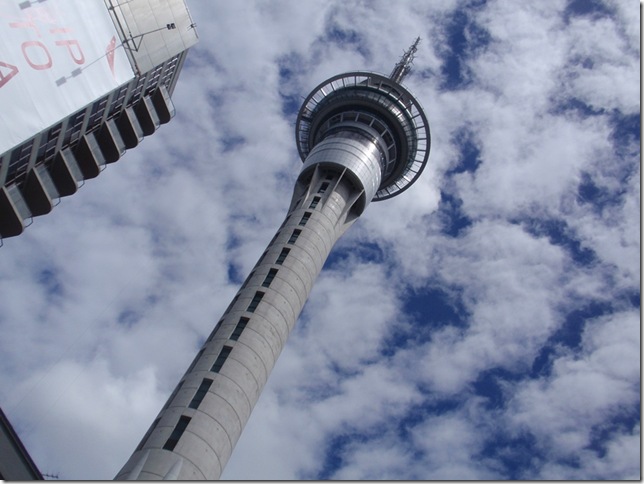 Mom’s pic of the Auckland Sky Tower
Mom’s pic of the Auckland Sky Tower
Monday we took it easy in the morning but headed off for some sight-seeing in nearby Rotorua around midday. We stopped at the infamous fresh fish (pronounced “fush” in Kiwi) ‘n chips shop here in Tauranga, right along the harbor where the fishing boats unload. The hogi fish was as fresh and tender as any of us had ever had. We enjoyed watching the local kids fishing for hogi but reeling in seaweed.
Our next stop was a crowd-pleaser as well. Dallas and I had passed the enormous kiwi advertising the Kiwi 360 exhibit several times but did not expect it to be so interesting. We toured the orchards that were used to grow 65 varieties of fruit as well as much of the kiwi that you might buy in the store back in the U.S. Apparently the conditions here in the Bay of Plenty (i.e., the volcanic ash in the ground, the occasionally freezing temps, and plenty of sun and rain) are ideal for growing kiwi, which I now believe is the healthiest of fruits (more vitamin C than an orange, more potassium than a banana). After the tour, we had the opportunity to taste the green (what we are used to) and gold varieties of kiwi as well as some kiwi wine and liqueur.
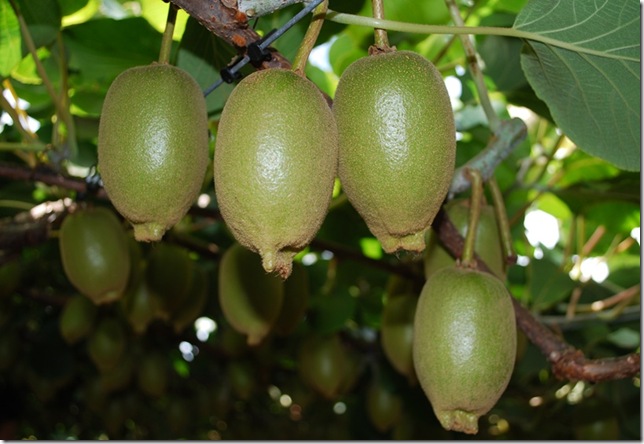 The unique gold variety was less sweet but hairless
The unique gold variety was less sweet but hairless
Rotorua is the 2nd biggest site for tourism in NZ (2nd to Queenstown), and we can appreciate why. There was something to do everywhere we looked, but we arrived late in the day, so we opted for the Museum of Art and History since it was open late. This area is the site where the first Maori settlers made their homes around 800 A.D., taking advantage of the warm ground water created by geothermal activity. They capitalized on the European tourists’ interest in the Pink Terraces there, considered to be the 8th Wonder of the World until it (along with two Maori villages) was destroyed by eruption of Mount Tarawera in 1886. European settlers later built up the city of Rotorua on top of the crater that remained, and interest in the hot baths (considered to be healing) created by piping in the warm (but stinky and sulphorous) ground water brought wealthy tourists and patients of various ailments from all over Europe.
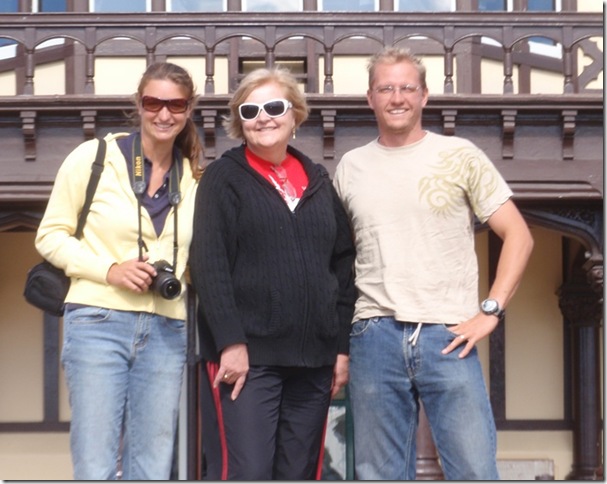 Having a great time as tourists!
Having a great time as tourists!
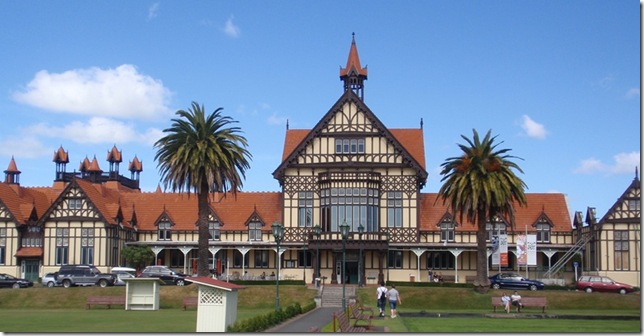 The former Bath House is now the site of the Rotorua Museum
The former Bath House is now the site of the Rotorua Museum
Tuesday we took a break from learning about the area but certainly enjoyed the natural beauty as we hiked to the top of nearby Mount Mauao. It was a gorgeous, sunny day, just perfect for viewing the beaches of Tauranga from above. It is a fairly steep climb, though, so our gelato afterward was well deserved!
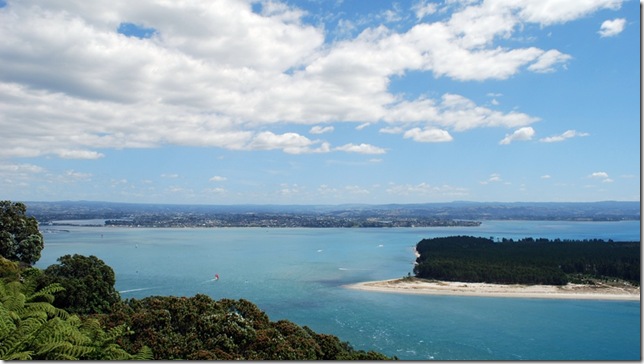 There were beautiful views all the way up the mountain
There were beautiful views all the way up the mountain
I should mention that Dallas and Dad have been doing some boat work (naturally). They took all four of our primary sails to the sailmaker for repairs, and Dad just took Dallas up the stick so that he could run some halyards that will be used to support the mast while the forestay is taken down and made to be adjustable. Dad will be ready for a vacation from his vacation when he gets home!
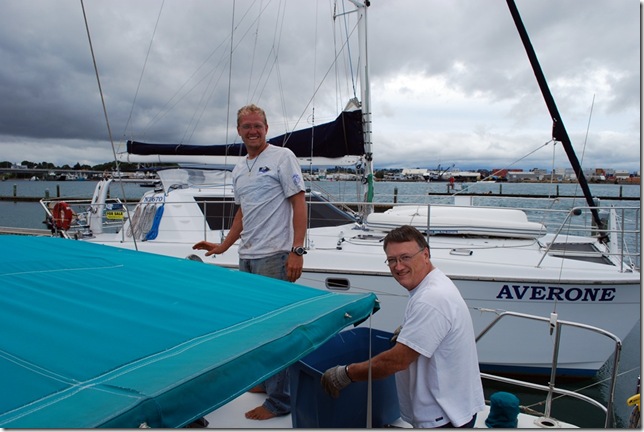 Getting the anchor chain out and ready to be re-galvanized
Getting the anchor chain out and ready to be re-galvanized
Today we are preparing to move the boat to the boatyard on the other side of the harbor so that her bow can be repaired while we are traveling around the South Island. We are headed to wine country in the Napier area later today and will continue south to Wellington tomorrow be ready to catch the ferry to the South Island on the morning of the 8th. Can’t wait!


